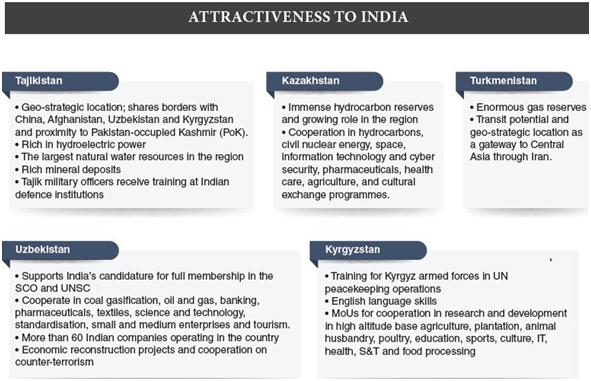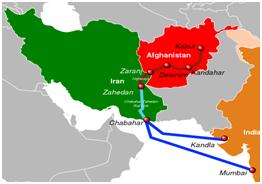‘Continuity in India’s ties with Central Asia’
GS-II: Effect of Policies and Politics of Developed and Developing Countries on India’s interests, Indian Diaspora.
|
Sub-topic GS-II: Effect of Policies and Politics of Developed and Developing Countries on India’s interests, Indian Diaspora. |
-
Context
As India cements its position as one of the fastest-growing major economies of the world, its increased engagement with the Central Asian region can lead to mutually beneficial gains — both in economic and strategic terms.
-
Background
- India has a long history of cultural and commercial relations with Central Asia, facilitated by its geographical proximity and the Silk Route.
- However, India-Central Asia relations stagnated in the 20th century, due to the Anglo-Russian rivalry in the “Great Game” and the consequent emergence of nation-states with differing ideologies.
- The Great Game, also known as ‘BolshayaIgra’, which started in 1830 was intense rivalry between British and Russia empires over Central Asia and the trade routes.
- Britain sought to influence or control much of Central Asia to buffer the “crown jewel” of its empire, and Russia sought to expand its territory and sphere of influence.
- After the breakup of the Soviet Union and the formation of the independent republics in Central Asia, India redesigned its ties with the region.
- However, in recent times, India has adopted a coherent strategy to upscale its relationship with CA and reinvigorate the ancient socioeconomic and traditional ties with the region through new initiatives.
-
Analysis
What is Central Asia?
- Central Asia is a landlocked region, which is located in the heart of Asia.
- Central Asia is composed of the 5 post-soviet countries: Kazakhstan, Uzbekistan, Turkmenistan, Kyrgyzstan and Tajikistan.
- The countries are also known as 5 “Stans” due to the same ending in their names.
- It is bounded on the north by Russiaand on the south by Iran, Afghanistan, and China.
-
Why Central Asia assumes significance for India?
- Geostrategic location: Central Asia, forms a part of India’s extended neighbourhood. Its geographical proximity, strategic location, and historical linkages make it an important partner for New Delhi.
- Energy: Central Asia is significant for India as it has an abundance of oil and gas deposits.
- The region contains vast hydrocarbon fields both on-shore and off-shore in the Caspian Sea which homes around 4 percent of the world’s natural gas reserves and approximately 3 percent of oil reserves.
- Gas in Turkmenistan
- Oil, gas and uranium in Kazakhstan
- Uranium and gas in Uzbekistan
- Hydropower in Tajikistan and Kyrgyzstan
- Global power hub: Strategically, Central Asia is emerging as the next high-stakes competition ground for global powers, hence, it would behoove India to pay closer attention.
- Significant transportation hub: Central Asia is a major transportation hub for gas and oil pipelines and multi-modal corridors connecting China, Russia, Europe, and the IOR.
-
How India is increasing engagement with the region?
- India-Central Asia Dialogue: As a part of moving India’s engagement with the region forward, the first India-Central Asia Dialogue was held in Samarkand, Uzbekistan on 13 January 2019. The participants included India, the five Central Asian republics and Afghanistan. The second India-Central Asia Dialogue was hosted virtually in October 2020.
- India is also involved in three connectivity initiatives that involve Central Asia. These initiatives are the International North South Transport Corridor (INSTC), the Ashgabat Agreement and the development of Chabahar Port in Iran.
Connectivity Initiatives
- TAPI Pipeline: The long-delayed Turkmenistan-Afghanistan-Pakistan-India (TAPI) pipeline, backed by the Asian Development Bank (ADB), was first proposed in the mid-1990s and all four actors officially signed an intergovernmental agreement in 2010.
- Chabahar port: The Chabahar port that was recently made partially operational gives New Delhi direct land access to Central Asia.
- International North–South Transport Corridor (INSTC): In the last few years, India has invested in projects such as the International North–South Transport Corridor (INSTC). India sees the INSTC as an import-export route to Russia, Europe and Central Asia.
- Engagement with the region in 2020 saw a clear focus on issues of regional economic development, connectivity, and security — apart from the immediate need of dealing with the ongoing pandemic.
- Among the highlights was the announcement of an additional 1 billion USD Line of Credit extended by India for priority development projects in energy, healthcare, connectivity, IT, agriculture, education, etc.
- India’s ‘Connect Central Asia Policy’ covers an entire gamut of a multi-model approach to strengthen politico-economic, security, and cultural ties between the two.
- The policy received a significant boost in 2018, when New Delhi’s diplomatic efforts paid dividends in the form of admission into the Ashgabat Agreement, signed in 2011 between Iran, Oman, Turkmenistan and Uzbekistan and Qatar, for the establishment of an international transport and transit corridor.
-
Understanding India’s constructive approach
- India, for its part, has so far chosen to take the ‘constructivist’ approach.
- Subsequently, India revived its “Indian Technical and Economic Cooperation” (ITEC) programme to provide assistance to the CARs countries, as well as capacity building through training programmes, study tours, technology transfers and, in some cases, aid for disaster relief.
- The ITEC programmes covered information technology, management, journalism, diplomacy, entrepreneurship, and banking.
- New Delhi also signed the Strategic Partnership Agreements (SPA) with three of the five CARs—Kazakhstan, Tajikistan and Uzbekistan—to stimulate defence cooperation and deepen trade relations.
- New Delhi has established Indian Cultural Centres in Kazakhstan, Tajikistan and Uzbekistan.
- New Delhi’s constructivism is more concretely manifested in its ‘Connect Central Asia’
- The policy, launched in 2012, aimed to enhance India’s political, economic, historical and cultural connections with Central Asia.
- As a region, Central Asia has received special attention in Prime Minister Modi’s foreign policy. India has designated Central Asia as part of its extended neighborhood.
- In 2015 Modi visited all the five Central Asian countries – Kazakhstan, Kyrgyzstan, Tajikistan, Turkmenistan and Uzbekistan – in a period of one week.
- He became the first Indian prime minister to visit all the five Central Asian countries in a single trip.
-
What needs to be done?
Efforts are now being made to address the weak trade ties by encouraging cooperation among businesses on both sides, as is evident in the launch of the India-Central Asia Business Council in 2020. However, various other measures can also effectively strengthen the ties:
- Strategic and economic cooperation: India also needs to direct investment to the region to reap the economic benefits of the strategic location of Central Asia that puts it at the crossroads of key trade and commerce routes. Sectors like the construction industry, sericulture, pharmaceuticals, IT, and tourism offer potential for collaboration.
- People-to-people tie: India must increase its developmental and humanitarian aid to the region and promote closer people-to-people ties through education, knowledge transfer, medicine and health, culture, cuisine, and tourism.
- Multilateralism: While India has strong relations with the U.S., it needs to apply multilateralism in Central Asia.
- First, India needs to define its economic and strategic interests in the region.
- Second, India must explore the extent to which it can act independently of the U.S. regarding Iran, Afghanistan and the Central Asian countries.
- Utilizing multilateral organization: Multilateral organisations like SCO, EAEU, and CICA can serve as platforms for sustained engagement and regular exchange of ideas.
Shanghai Cooperation Organisation (SCO)
- SCO is a permanent intergovernmental international organisation, created in 2001 in Shanghai (China) by Kazakhstan, China, Kyrgyzstan, Russia, Tajikistan, and Uzbekistan.
- The SCO currently comprises eight Member States (China, India, Kazakhstan, Kyrgyzstan, Russia, Pakistan, Tajikistan and Uzbekistan), four Observer States interested in acceding to full membership (Afghanistan, Belarus, Iran, and Mongolia) and six “Dialogue Partners” (Armenia, Azerbaijan, Cambodia, Nepal, Sri Lanka and Turkey).
Eurasian Economic Union (EAEU)
- EAEU is an international economic union and free trade zone comprising countries located in central and northern Asia and Eastern Europe.
- The founding member states of Belarus, Kazakhstan, and Russia established the union by treaty in 2014 and officially implemented the agreement beginning on Jan. 1, 2015.
Conference on Interaction and Confidence-Building Measures in Asia (CICA)
- CICA is an inter-governmental forum for enhancing cooperation towards promoting peace, security and stability in Asia.
- CICA members consist of: Afghanistan, Azerbaijan, Bahrain, China, India, Iran, Iraq, Israel, Jordan, Kazakhstan, Kyrgyzstan, Egypt, Mongolia, Pakistan, Palestine, South Korea, Russia, Tajikistan, Thailand, Turkey, United Arab Emirates, Uzbekistan and Vietnam.
-
Conclusion
How far India and Central Asian countries will take this renewed, centuries-old relations remains to be seen. India must take into consideration its future energy needs and the market potential of the greater Eurasian region, and seize the opportunity to stretch its economic borders while maintaining its constructive approach.




